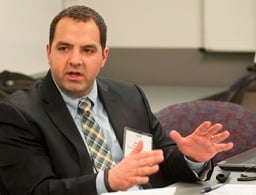Medical residents today must demonstrate that they can successfully participate as contributing members of interprofessional teams, so medical schools are working through barriers to incorporate interprofessional education (IPE) into their curricula to give students a firm grounding when they begin providing care.
The Accreditation Council for Graduate Medical Education integrated interprofessional learning into its competency milestones because physician-led health care teams provide the best—and safest—care. Residents must be able to discern how to personally contribute to the team and prioritize the team’s needs over personal needs to optimize the delivery of care. IPE also helps physicians in training understand their own roles and personal limitations as physicians and how to seek assistance from other team members when necessary.
Many medical schools are giving future physicians a jump-start on working in teams to prepare students for the health care systems they soon will enter. Paul George, MD, director of second-year curriculum at the Warren Alpert Medical School of Brown University (pictured left), discussed IPE at the recent AMA consortium meeting for schools that received grants through the AMA’s Accelerating Change in Medical Education initiative. Brown already has incorporated IPE into its curriculum as part of its AMA grant project.
“In undergraduate medical education, we have the hope that [IPE] grounds students in team-based care prior to graduation,” Dr. George said. “When they get to GME and beyond, working in teams will be second nature, and there’s no hierarchy.”
Brown has developed two workshops required across several different health professions schools. In the workshops, students from different health professions must work together to create specific patient care plans, negotiating the roles each will play in the care plan and taking the lead when appropriate.
The University of Michigan Medical School is working across its health professions schools as well, piloting new courses that bring students from different disciplines together. A recent pilot placed nursing and social work students with medical students and required them to work on breaking bad news to patients. Another pilot placed nursing students in clinical rotations with pediatric dentistry students.
But both schools are exploring how to break down barriers to fully integrating IPE into their curricula.
For Brown, the challenge is finding other health professions schools to work with because the school doesn’t have its own. Dr. George said the medical school has had to seek out partners from other areas in Rhode Island, such as the University of Rhode Island and Rhode Island College. Getting students to and from the various schools isn’t easy.
The University of Michigan does have health professions schools, but not all the schools are on the same academic schedules, and coordinating how to keep track of students in different schools has proved an issue as well.
“We have pharmacy, nursing, social work, public health and kinesiology, but we’re still stuck in the model of silos, [and] we have all our own curriculum,” said Joseph House, MD, assistant professor of pediatrics and communicable diseases and assistant professor of emergency medicine at the University of Michigan Medical School (pictured left). “We can hear the music, but we’re waiting for a dance partner.”
Even classroom space—the right kind of space and enough of it—is proving difficult to coordinate IPE. Faculty buy-in and development also has been a challenge. The University of Michigan is implementing faculty development in IPE, establishing an interdisciplinary group of educators that will work through a standardized patient case for students across health professions schools to use going forward.
But IPE can be done, said George Thibault, MD, president of the Josiah Macy Jr. Foundation.
“It has to come from the top,” Dr. Thibault said. “Deans are absolutely important. It is hard when you cross schools, and deans are the only ones that can overcome these barriers.”
For now, Brown, the University of Michigan and the other nine AMA consortium schools implementing innovations in medical education will continue to work through roadblocks. Among other solutions, the consortium will look into how technology and virtual learning might play into IPE, which could alleviate the challenge of appropriate space and coordinating student schedules.
To learn more about IPE, attend the education session of the AMA Section on Medical Schools, held during the 2014 AMA Annual Meeting.





